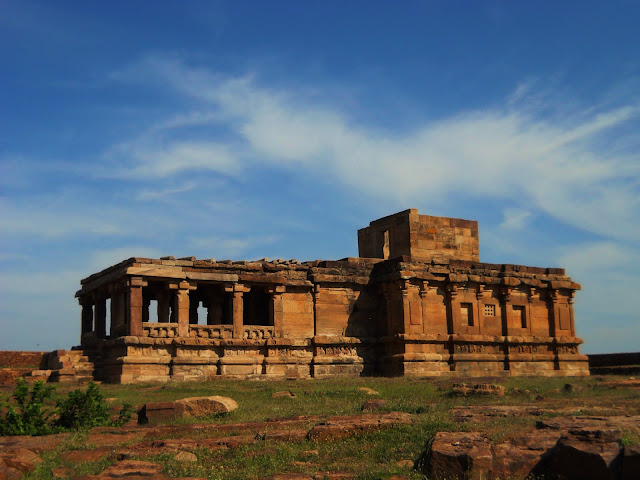Ravana Phadi cave temple in Aihole,Karnataka
Nataraja, in the Ravana Phadi cave temple in Aihole, flanked by Ganesh. Nataraja is the form of Shiva whose dance of cosmic destruction will obliterate the old universe in preparation for the new. The Ravana Phadi Cave, dating back to the 6th century, is one of the very earliest Chalukyan monuments, predating the cave temples at Badami. Though Chalukyan architecture would develop a great deal between the this period and the 8th century, their skill at sculpting appears to have peaked rather earlier. For my money at least, the very greatest Chalukyan carvings, which certainly include this Nataraja, are in Aihole...Aihole is actually pronounced "Aye-oh-lei," and frankly I wish that whoever decided to render the name into English had gone a more phonetic route...talking about it actually presents exactly the same problem as bringing up the name of the planet Uranus...oh well....
Pattadakal, now a UNESCO World Heritage Site, was where the focus of Chalukyan building activity shifted after Badami. It was for a time their capital city, and it was where, in the 7th and 8th centuries, the Chalukyan style of architecture reached its most advanced stage. Here, in an incredibly dense complex of ancient buildings, a profusion of temples in Northern and Southern styles stand side by side. Being there is like walking through a whole landscape of bizarre red sandstone mountains.

Various Pattadakal temples in different styles. The large pyramidal tower in the background is part of the Virupaksha Temple, the most famous shrine at the site. The large curvilinear structure in the foreground is the Sikhara of the Kashi Vishwanatha temple, built by the immediate successors of the Chalukyas in the region, the Rashtrakutas, though in a Chalukyan style.

Looking towards the Sikhara, or tower, of the early 8th century Virupaksha temple, the largest temple and most impressive construction at the site. Dedicated to Shiva, the temple was built by a certain Chalukyan Queen Lokamahadevi to commemorate her husband Vikramaditya's military victories over the Pallavas, a neighbouring ancient South Indian dynasty. This Virupaksha temple is not to be confused with the much later Hampi Virupaksha Temple (which I happened to visit just a few days later).

A closer view on the tall, finely sculpted Sikhara of the Virupaksha temple. This is an example of a Chalukyan temple that tends more towards the Southern School of temple architecture, the Sikhara being pyramidal rather than curvilinear.

A fine illustration of the differences between the Northern and Southern types of Sikharas. The temple tower in the foreground is classicly South Indian, while the temple in the background is typically North Indian in style. However, there are few places in India where you can capture both types of temple in one photograph.

Close up on a finely carved though somewhat weather beaten South Indian style Sikhara.

The partially ruined Galganatha temple, built in a pronounced North Indian style. What is perhaps most interesting about the stylistic choices of the temple builders of Pattadakal is the fact that neither Northern or Southern styles of temple really won out. Rather, throughout the period during which the site was active, a roughly equal number of Northern and Southern style temples were built.
Narasimha, the lion headed 4th avatar of Vishnu, about to slay the demon Hiranyakashipu. From a frieze on the side of the Mallikarjuna Temple. Narasimha is generally regarded as an embodiment of divine wrath. In the story of Narasimha and Hiranyakashipu, the form of Vishnu which preceded Narasimha, the boar headed Varaha, killed Hiranyakashipu's brother, Hiranyaksha. Seeking revenge, Hiranyakashipu did penance and then appealed to Brahma for immortality. Brahma wouldn't accede to this, though he did allow certain conditions to be placed on Hiranyakashipu's death, among which was the stipulation that he could be killed be neither man nor animal. Later, after the demon had been granted essentially de facto immortality, his son became a devotee of Vishnu. This angered Hiranyakashipu so much that he tried to kill his son, but Vishnu protected him and sent his avatar Narasimha to intervene. As Narasimha was part human and part lion, he was technically neither a man nor an animal, and hence was able to slay the demon.

Golden light inside the Mallikarjuna temple. The Mallikarjuna temple is a very close, though slightly smaller, imitation of the next door Virupaksha temple, and was in fact built only around 15 years later, by a different queen of the same ruler for whom the larger and more famous temple was built.

Inside the Mallikarjuna temple...it looks almost exactly like the inside of the Virupaksha Temple, and actually, the only reason I have pictures of the inside of this temple rather than the temple it was modeled after is because the Virupaksha temple had more people in it, but in order to get these relatively low light pics with my little point and click camera, I needed to be able to stand really really still, and I couldn't have people walking through the frame.

Carved pillars inside the Mallikarjuna temple.
While inside the Mallikarjuna temple, I aquired a few small though very persistent kids who wanted to beg from me. I gave them a little bit of candy and some bananas, but they would only be satisfied with rupees. For the next ten minutes or so I wound up being chased around the whole UNESCO World Heritage site, before I got fed up and turned on the kids, literally running them screaming out of the complex, and then most of the way out of the surrounding town. I got some more very puzzled looks from local visitors. Then I continued my tour of the site.

A frieze carved on the side of a pillar depicting a scene from the Mahabharata, the 3000 year old sanskrit epic, inside the Virupaksha temple.
 More Mahabharata scenes. It's fairly amazing to note that the Mahabharata had been in existence for over 1500 years by the time this carving was made.
More Mahabharata scenes. It's fairly amazing to note that the Mahabharata had been in existence for over 1500 years by the time this carving was made.
Matrikas in Ravana Phadi Cave, Aihole. Ravana Phadi Cave, dedicated to Shiva, dates from the 6th century, and predates the cave temples temples in Badami. The picture at the top of this post is from Ravana Phadi Cave. The Matrikas are a group of mother goddesses, usually numbered at seven (though that can vary) who are regarded as the female personifications of the energy of the more important Gods. The sow headed figure to the left is Varahi, who is considered the living form of the energy of Varaha, the third avatar of Vishu. It's interesting to speculate how much historical data these carvings contain with regards to the clothing of the period. In particular, I wonder if those rather fanciful headdresses are simply an artist's invention, or if they actually reflect something which might have been worn in the Chalukyan court.
More carvings in Ravana Phadi Cave. The figure in the center is Shiva, with Paravati to one side. The malnourished fellow on the other side is, I think, a figure named Bhringi, and every story I've run across as to who exactly he is is different. One story was that he was a demon who fell in love with Parvati, so in retribution Shiva drained all his fluids out, and he became Shiva's devotee. I've also read that he was in fact Shiva's next son after Ganesh. Also, in another story I heard that he was actually a saint who was, quite contrary to the first account, entirely devoted to Shiva, to such an extent that he wanted to totally ignore Parvati. In this version, Parvati, angry at being ignored, then decided to drain Bhringi of all of the parts in his body that are, in Tantric Hinduism, associated with female energy, i.e., all the soft squishy stuff, leaving Bhringi in the state you see him in this carving: A bag of bones, still devoted to Shiva...In short, in Indian mythology, they don't make it easy on you...
Durga Temple, Aihole. This is the most famous temple in Aihole, and perhaps the most unusual in the whole region that constituted the core of the Chalukyan Empire. The name of the 8th century temple comes not from the goddess Durga, but rather from the word "Durg" meaning fortress, which is what the temple served as at one point. The identity of the God who was venerated here is in fact unknown. The layout of the temple is unique, the curved colonnade around the outside of the building being a design feature that does not appear anywhere else in South Indian temple architecture. Some historians speculate that the shape of the temple was inspired by earlier Buddhist shrines, which had a somewhat similar floorplan, though the design on the Durga Temple itself was never copied, and seems to have been something of an architectural dead end.
A rather marvelous Durga, on the side of the Aihole Durga temple, which happens not to be named after Durga. To the left is her lion mount, and to the right, the Buffalo demon Mahishasura, who I assume she is about to slay, though her weapon has since worn away, along with one of her legs and some of her arms. As you walk along the colonnade on the outside of the Durga temple, you pass by a number of panels depicting six of the more important Hindu Gods.
Shiva with Nandi, also on the side of the Durga temple.
There are something like (depending on your source) 150 temples in Aihole, in a number of different groups and from a variety of historical periods. But as I had come, without planning on it, all the way from Badami, I had to visit Aihole at rather more of a rushed pace than I would have liked.
A small carved Buddha, in another, very early, 6th century shrine.
The unfinished Meguti Temple, which was constructed by a Jain scholar in the Chalukyan court in the 7th century. It's noteworthy in that it's the only temple in Aihole with a precise date, an inscription on the temple indicating that it was constructed in 634. Though a tower was probably planned, it was never added. The temple now just has another, smaller, shrine on top.
Weird arcane scribblings. Make of them what you will. These were some distance from the trail, next to a small abandoned temple. I have no idea how old these symbols are, or who put them there. Perhaps they're just some sort of weird hoax, or maybe they're just not that old.
Close in on the weird symbols. I would be inclined to think that these were fairly recent scribblings, if not for two facts that became apparent on close inspection. Firstly, the symbols seem to have been there long enough that bits of the rock that were once underneath them have been worn away over time. Also, those two black patches covering the bottom of the symbols would appear to be lichen, which generally grow at a rate of only a few millimeters per year. The symbols must have been there at least long enough for the lichen to grow to its current size, which would have taken quite some time.....What does that all add up to? I'm not sure, but it was interesting.
Leaving the ancient forlorn temple next to the mysterious symbols, I walked back to Badami under a steadily darkening sky. At one point a cobra crossed my tracks, and progressively more and more huge flying foxes could be seen above as I made my way westward. The day had truly been a spectacular, if unexpected, success...but that's just how it turns out sometimes.
Naga ceiling medallion on the roof of the front porch of the Aihole Durga Temple.



















No comments